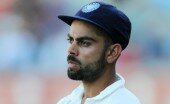Five things India needs to do to win the World Cup
Written by Suhrith // February 18, 2011 // Sport // No comments
These are not all-encompassing, nor are they, especially, novel ideas, but they constitute fundamental elements, which India must fulfil to have a chance of winning its second World Cup.
1. Pick the bowlers that suit the conditions
Pitches in the subcontinent, contrary to general perception, are not all slow, dry and low. Different grounds across the stretch of the region tend to produce surfaces that are varied in subtle yet vital ways and therefore, part of M.S. Dhoni’s job will be to rotate his bowlers to suit the playing conditions. Where possible though – except on pitches that have a clear propensity to aid the quicker bowlers – Dhoni must try and incorporate two frontline spinners in his line-up, for spin is clearly India’s biggest weapon. With Harbhajan Singh’s position in the Eleven considered unassailable, Piyush Chawla and Ravichandran Ashwin will vie for the second spinner’s spot. Chawla’s exemplary form in India’s two warm-up games coupled with the fact that Ashwin like Harbhajan is an off spinner, could see the leggie make the cut. If Chawla is preferred, a case may also be made for Suresh Raina to be included in place of Yuvraj Singh, considering that India will have a full-time spinner who can turn the ball away from the right-handed batsmen. Some believe, rightly in my opinion, that Raina should play ahead of Yuvraj, in any event, based on his superior batting record in the subcontinent in recent times and his excellent fielding skills. But that said, Dhoni seems to view Yuvraj’s bowling as a key cog in the present set-up and he is unlikely to drop him unless his performances are monumentally poor.
Additionally, the opponent’s team composition must also be considered before choosing between Chawla and Ashwin. Against teams littered with left-handed batsmen, Ashwin should be the preferred option. And if Ashwin is picked, Yuvraj, perhaps, irrespective of his batting form should be fielded to lend variety to the bowling attack.
2. Use Yusuf Pathan as a Floater
It is crucial that Yusuf Pathan’s destructive ability as a batsman is used to its maximum potential. Pathan looks to be at his most dangerous when batting at number seven, but India mustn’t fall into the trap of pigeonholing batsmen into set positions. He should be used as a floater in the order and must be accorded enough time to inflict the most severe damage upon the opponent. Pathan, perhaps, doesn’t need the aid of a power-play to do his thing, but it wouldn’t hurt to ensure that the batting power-play is used, if possible, when he is in the middle.
3. Use the Third Power-Play with Purpose
The third power-play – a stretch of five consecutive overs to be selected by the batting team when not more than three fielders can be placed outside the 30 yard circle – has rarely been used with ingenuity. Very often we see teams waiting until at least the 40th over, and in some cases even until the 45th over, before calling for the power-play. This may be sensible in some cases, but when a team is seven or eight wickets down, the batsmen at the crease are ill-equipped to make the most of the situation. If India can use the option creatively, even between the 15th and 20th over where the situation so demands, it can add exponentially to its batting totals.
4. Endeavour to pick wickets in the middle overs
India got many of its strategies wrong in the disastrous 2007 World Cup where it crashed out in the group stages, of which the bowling tactics in the middle overs, particularly, bordered on the ludicrous. The spinners were sought to be used as mere containing acts and the middle overs were seen as a time to check the flow of runs, with the team rarely looking at wicket-taking options. What ensued, though, were neither wickets nor an improved economy rate. (Here is a table which shows that the economy rate in the middle overs during the 2007 World Cup was directly proportional to the number of wickets picked) The spinners, therefore, need to be utilised as attacking weapons and as we saw in the practice games, nothing works like wickets in containing the run flow.
5. Place the right fielders in the right positions
In a recent address at Calcutta, Sir Vivian Richards and Steve Waugh both opined that the best fielding side will win the World Cup. For India’s sake, one hopes that their prophecies don’t come true. Virat Kohli and Suresh Raina – who may not feature in the Eleven – are the only world class fielders in the Indian squad and it is quite improbable that the team would be among the better fielding sides in the competition. That being the case, Dhoni needs to ensure, perhaps more than most other captains, that he gets the right fielders in the right positions. The likes of Munaf Patel, Ashish Nehra, Zaheer Khan, Yusuf Pathan and even Sachin Tendulkar, are poor ground-fielders, which means that Dhoni will have a great deal of hiding to attempt. But unless an effort is made towards that end, India can wave its chances of lifting the Cup, a big goodbye!



